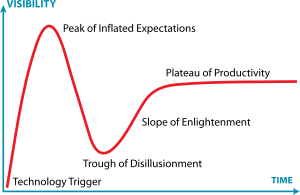About a dozen years ago, learning and development professionals thought performance support was bigger than Tom Hanks, Meryl Streep, and The Beatles all rolled into one. Conferences about performance support were filled to capacity. Help authoring tools such as Robohelp and Doc-to-Help were selling like hotcakes. Electronic performance support systems (EPSS) were the rage.
Performance support was so hot that some gurus and pundits predicted that courses were on their deathbeds. Why bother having people take courses to learn things they’ll soon forget? A better strategy is simply to provide individuals with the information they need at the precise moment that they need to perform a task. Rather than attempting to improve skills, the focus became how to integrate support into daily activities.
Gartner’s Hype Cycle provides an accurate description of the rise, fall, and current state of opinion regarding performance support.

That time a dozen years ago certainly marked the Peak of Inflated Expectations. This was followed a couple years later by a deep Trough of Disillusionment. During this trough phase, people starting thinking that maybe skills really do matter. Also, software and hardware makers realized that more people would buy their products if they made them easier to use. Intuitive design became a higher priority. A software application or gadget shipped with a user guide suggested a failure of design. The best designed stuff was self-explanatory.
We’re likely now approaching the Plateau of Productivity for performance support. Learning professionals have realized that conventional learning events such as courses can co-exist peacefully with performance support resources. Not only can these two strategies mesh, they can, in fact, leverage the same environment and content.
A learning management system (LMS) can be used as a performance support platform if it can quickly provide access to the small bits of content required to performing a task. If someone needs to log into a LMS, find and enroll in a course, and navigate through a long lesson, the individual will think `this sucks` and will look for alternatives to get the required information.
Consider the following in using your learning management system for performance support:
- Speed of access to information should be your primary consideration. Make a poster to remind you of this and put it on your wall. Or, consider a tattoo.
- Keep lessons and resources short. If the answer to a question is located midway through a long course or on page 12 of a 20-page PDF, learners will give up and e-mail a colleague for help.
- Consider implementing single sign on (SSO) between whatever applications an individual is using and your LMS. This will eliminate the need for people to log into the LMS when accessing performance support materials.
- Instead of forcing people to search for the content they need, use `deep links` to point learners directly to the appropriate material.
What’s a deep link?
Rather than pointing a learner to their LMS dashboard, a deep link takes a learner directly to the information they need within the LMS, whether that be a course or a lesson within a course. For example:
- A link such as http://www.mylearningsite.com would take the learner to their main dashboard
- A link such as http://www.mylearningsite.com/u/?_cid=122532* would take the person to a course
- A link such as http://www.mylearningsite.com/u/?_lid=412353 would take a person to a specific lesson within a course
- A link such as http://www.mylearningsite.com/u/?_rid=652351 would take a person to a specific resource such as a PDF document
By embedding deep links in the applications an individual works with each day (Intranet, custom software applications, CRMs, etc.), or by sending deep links via e-mail, a learner can be taken directly the information the need immediately. Upon clicking a deep link, the learner could, for instance, see something like this:
*The syntax for deep links differs between different LMS. Contact your vendor for details on how to deep link within your platform.


